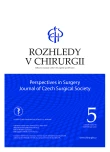Liver abscess as a rare complication of PEG
Authors:
M. Smolár; A. Mikolajčík; I. Dedinská; M. Hošala; Ľ. Laca
Authors‘ workplace:
Chirurgická klinika a Transplantačné centrum, Univerzitná nemocnica Martin
Published in:
Rozhl. Chir., 2019, roč. 98, č. 5, s. 219-222.
Category:
Case Report
Overview
Introduction:
Percutaneous endoscopic gastrostomy (PEG) is one of the most effective methods of providing long-term enteral nutrition in patients with the impossibility of oral intake. Complications are relatively common. The most common is peristomal wound infection at the site of the insertion and leakage along the cannula. Lesscommon complications are colo-cutaneous fistulas and peritonitis. A very rare complication is liver abscess.
Case report:
The authors describe a case of a 51-year-old man with a hepatic abscess with inoperable pharyngeal carcinoma with PEG. The patient was admitted to hospital with a developing septic condition due to a liver abscess. The liverabscess resulted from the buried bumper syndrome of the PEG and subsequent complete dislocation of the bumper into the left liver lobe area.. This condition was treated by a surgical review with abscess drainage and the construction of classical gastrostomy.
Conclusion:
Buried bumper syndrome with its complications, such as a liver abscess is a relatively rare complication, but challenges both the diagnosis and therapy of the syndrome itself. Its management requires a close cooperation between a gastroenterologist and a surgeon. Early recognition and treatment can prevent the progression of the condition to sepsis or a septic shock, which can lead to death.
Keywords:
buried bumper syndrome – PEG – liver abscess – gastrostomy
Sources
- Gauderer MW, Ponsky JL, Izant RJ. Gastrostomy without laparotomy: a percutaneous endoscopic technique. J Pediatr Surg. 1980;15:872–5.
- Laasch HU, Wilbraham L, Bullen K, et al. Gastrostomy insertion: comparing the options--PEG, RIG or PIG? Clin Radiol. 2003;58:398−405.
- Kala Z, Vomela J, Hanke I. A technic for laparoscopic gastrostomy. Rozhl Chir. 1995;74:216-8.
- Rahnemai-Azar AA, Rahnemaiazar AA, Naghshizadian R, et al. Percutaneous endoscopic gastrostomy: indications, technique, complications and management. World J Gastroenterol. 2014;20:7739–51. doi: 10.3748/wjg.v20.i24.7739.
- Itkin M, DeLegge MH, Fang JC, et al. Multidisciplinary practical guidelines for gastrointestinal access for enteral nutrition and decompression from the Society of Interventional Radiology and American Gastroenterological Association (AGA) Institute, with endorsement by Canadian Interventional Radiological Association (CIRA) and Cardiovascular and Interventional Radiological Society of Europe (CIRSE) Gastroenterology 2011;141:742–65.
- Hucl T, Spicak J. Complications of percutaneous endoscopic gastrostomy. Best Pract Res Clin Gastroenterol. 2016;30:769−81.doi: 10.1016/j.bpg.2016.10.002.
- Cyrany J, Rejchrt S, Kopacova M, et al. Buried bumper syndrome: A complication of percutaneous endoscopic gastrostomy. World J Gastroenterol. 2016;22:618-27. doi: 10.3748/wjg.v22.i2.618.
- Artul S, Nseir W, Assaf V, et al. Abdominal wall necrotising fasciitis due to dislodged percutaneous endoscopic gastrostomy tube. BMJ Case Rep. 2014. doi: 10.1136/bcr-2013-201346.
- Van Weyenberg SJ, Lely RJ. Arterial hemorrhage due to a buried percutaneous endoscopic gastrostomy catheter. Endoscopy 2013;45 Suppl 2 UCTN:E261–E262. doi: 10.1055/s-0033-1344566.
- Gubler C, Wildi SM, Bauerfeind P. Liver injury during PEG tube placement: report of two cases. Gastrointest Endosc. 2005;61:346–48.
- Burke DT, Geller AI. Peritonitis secondary to the migration of a trans-hepatically-placed percutaneous endoscopic gastrostomy tube: a case report. Arch Phys Med Rehabil. 2009;90:354–57.
- Rafiq A, Abbas N, Tariq H, et al. Gastro-hepatic fistula with liver abscess: A rare complication of a common procedure. Am J Case Rep. 2015;16:652−7. doi: 10.12659/AJCR.895098.
- Tam A, Wagner-Bartak NA, Wallace MJ et al. Liver abscess after inadvertent transhepatic transgression during percutaneous fluoroscopy-guided gastrostomy. Clin Radiol. 2008;63:731−5. doi: 10.1016/j.crad.2007.09.007.
- Binnebösel M, Klink CD, Otto J, et al. A safe and simple method for removal and replacement of a percutaneous endoscopic gastrostomy tube after “buried bumper syndrome” Endoscopy 2010;42 Suppl 2:E17–E18.
- Piskac P, Wasiková S, Hnízdil L, et al. Buried bumper syndrome (BBS) as a complication of percutaneous endoscopic gastrostomy. Rozhl Chir. 2010;89:298–9.
Labels
Surgery Orthopaedics Trauma surgeryArticle was published in
Perspectives in Surgery

2019 Issue 5
Most read in this issue
- Acute hiatal hernias
- An alternative method of surgical treatment in refractory GERD following laparoscopic sleeve gastrectomy
- Rare causes of acute appendicitis
- Early surgical management in patients with burns
